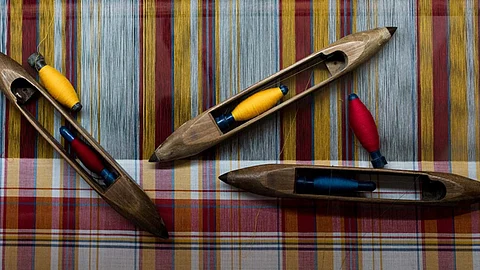
- HOMEGROWN WORLD
- #HGCREATORS
- #HGEXPLORE
- #HGVOICES
- #HGSHOP
- CAREERS
- ABOUT US
- CONTACT US

Dear readers, today I have a story for you that is a sweet concoction of fashion history and a masterstroke of advertising brilliance. The protagonist of this story is Bleeding Madras, hand-spun yarn woven in India, that reached the height of its popularity in the 1960s. Let us delve into the history of this fabric, that has such a unique name.
South India has always attracted fabric merchants from all over the world. Even if we transport in time as early as the first century, the Romans were here hauling off shiploads of silks and cotton. In the 1600s, Dutch ships reached the shores of South India. They established their first fort at Pulikat and then a trading station at Sadras, a weavers' colony renowned for its high-quality cotton. One particular item they traded in had its origins in the modest lungi (a garment similar to a sarong, wrapped around the waist and extending to the ankles, worn in various countries in Southeast Asia even today). This fabric, with its bright check designs dyed with natural colors, became extremely popular in Holland and came to be known as the Palaicatta checks.
Palaicatta was the Dutch name for Pulikat. Consequently, when the British colonial forces started marshaling these parts, this fabric started being called Madras checks. Huge quantities of this fabric were exported to Europe. In the 1950s, an American importer sold a lot of this fabric to upscale shops in the United States, including the famous Brooks Brothers, the oldest apparel brand in continuous operation in America. However, this naturally dyed fabric ran color with every wash.
Faced with customer backlash, Brooks Brothers called in an advertising genius, David Ogilvy, for his expertise. Ogilvy invented a new slogan for the fabric: "Magical things happen to the shirt when you wash it," said the campaign. The product was rebranded and came to be known as Bleeding Madras, the fabric that was guaranteed to fade. With one stroke of marketing genius, Ogilvy changed the game. All of a sudden, everyone wanted this unique material that changed color with every wash. In the 1960s, Bleeding Madras became all the rage.
Its famous mention in SE Hinton’s bildungsroman The Outsiders showcased how popular it was in America. The novel features teenage boys split into two rival gangs, each representing a distinct social stratum: the Greasers, known as the "Outsiders," with their rebellious spirit, long hair, and leather biker jackets; and the Socs, or "Socials" epitomizing preppy fashion with their "good grades, good cars, good girls, Madras, Mustangs and Corvairs." Here, madras symbolizes the Socs' affinity for clothing crafted from Madras checks. SE Hinton’s book shows how the fabric became deeply intertwined with the distinctive style and ethos rooted in the Ivy League and Country Club cultures of the northeastern United States.
The check design is still immensely popular in South India, but now it is made with chemical dyes instead. Bleeding Madras may not bleed anymore but no one can deny its distinctive history and special place in global fabric lore.
If you enjoyed reading this, here's more from Homegrown:
The Origins & The Cultural Legacy Of The Iconic Punjabi Paranda
Namrata Kumar's Sari-Themed Prints Capture The Strength & Beauty Of Indian Women
Spots, Stripes, And Stains: The Bewildering Legacy Of Colonial Taxidermy In India
